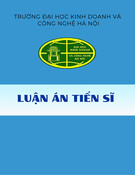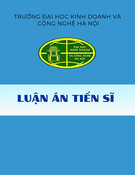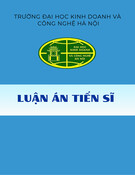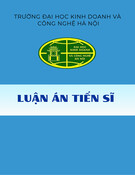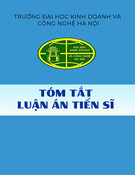1
GIỚI THIỆU LUẬN ÁN
1. Đặt vấn đề Biến chứng hô hấp là nguyên nhân hàng đầu dẫn đến tử vong và tàn tật sau phẫu thuật nói chung và phẫu thuật ổ bụng trên nói riêng. Tỷ lệ biến chứng hô hấp sau mổ rất thay đổi, giao động từ 2 - 40% tùy thuộc vào từng nghiên cứu, từng tiêu chuẩn chẩn đoán, trong đó tỷ lệ biến chứng cho phẫu thuật bụng trên là 32%, phẫu thuật bụng dưới là 16%, con số này là 30% đối với phẫu thuật lồng ngực. BCHH làm kéo dài thời gian nằm viện, tăng chi phí điều trị, mức độ ảnh hưởng là rất lớn, thậm chí còn lớn hơn so với biến chứng tim mạch.
Các BCHH dù ở dạng nào đều gây ra giảm oxy máu động mạch có hoặc không kèm theo tăng CO2. Nhờ khí máu động mạch các bác sỹ có thể xác định chắc chắn bệnh nhân có giảm oxy máu động mạch không, mức độ nào dựa vào phân số trao đổi khí PaO2/FiO2. Giảm oxy máu động mạch (hypoxemia) mức độ nhẹ hay trung bình chưa gây nguy hiểm nhưng nếu tình trạng này xuất hiện kéo dài hoặc xuất hiện ngắn trên bệnh nhân đã có suy giảm chức năng cơ quan từ trước thì vấn đề sẽ trầm trọng hơn và có thể dẫn đến thiếu oxy tổ chức (hypoxia) hay suy đa tạng. Điều này đã nâng tầm quan trọng của việc theo dõi phát hiện và dự phòng sớm giảm oxy máu động mạch sau mổ.
Chức năng hô hấp sau mổ bị ảnh hưởng bởi rất nhiều yếu tố, điều này đồng nghĩa với việc giảm oxy máu sau mổ so với trước mổ là không thể tránh khỏi, vấn đề ở chỗ là mức độ giảm ra sao, bệnh nhân có yếu tố gì thì mức độ giảm sâu hơn. Giảm oxy máu sau phẫu thuật ổ bụng đã được nhiều tác giả tập trung nghiên cứu để tìm ra các yếu tố nguy cơ độc lập của giảm oxy máu sau mổ, trên cơ sở đó đưa ra các biện pháp dự phòng nhưng các kết quả còn rất khác nhau.
Thêm nữa, giá trị của các test đánh giá về chức năng thông khí phổi hay khí máu trước mổ trong việc tiên lượng giảm oxy máu sau mổ
2
đến đâu và vai trò của khí máu động mạch giai đoạn sớm sau mổ trong việc tiên lượng BCHH sau mổ thế nào vẫn còn nhiều tranh luận trên thế giới. Đã có một số nghiên cứu khẳng định giá trị tiên lượng của giảm oxy máu động mạch trước mổ với việc xuất hiện BCHH sau mổ, nhưng không có nghiên cứu nào nói về giá trị của giảm oxy máu giai đoạn sớm sau mổ (khi bệnh nhân chưa có suy hô hấp thực sự hay chưa có BCHH) trong việc tiên lượng xuất hiện BCHH giai đoạn sau.
Tại Việt Nam chưa có nghiên cứu về rối loạn oxy máu hay BCHH sau phẫu thuật bụng vì vậy chúng tôi tiến hành nghiên cứu đề tài “Đánh giá sự thay đổi khí máu động mạch sau mổ và các yếu tố nguy cơ của giảm oxy máu động mạch ở bệnh nhân đƣợc phẫu thuật bụng” với các mục tiêu:
1. Đánh giá sự thay đổi khí máu động mạch trong những ngày đầu sau mổ ở bệnh nhân được phẫu thuật bụng có giảm đau theo đường ngoài màng cứng. 2. Xác định các yếu tố nguy cơ của giảm oxy máu động mạch sau mổ ở bệnh nhân được phẫu thuật bụng.
2. Tính thời sự của luận án
Nguy cơ tử vong và biến chứng trong phẫu thuật đã được quan tâm và kiểm soát đúng mức. Tuy nhiên để một ca mổ thành công thì ngoài việc theo dõi trước và trong mổ thì các chiến lược chăm sóc và dự phòng biến chứng sau phẫu thuật cũng phải được đầu tư. Khác với biến chứng chứng tim mạch, biến chứng hô hấp sau mổ cũng chiếm tỷ lệ cao, nặng nề thậm chí tử vong nhưng lại ít được quan tâm hơn, đặc biệt trong môi trong ngoại khoa ở Việt Nam - khi mà việc theo dõi sau mổ thường ngắn và được thực hiện bởi những nhân viên y tế khác chuyên khoa. Vì vậy, nghiên cứu của chúng tôi được tiến hành nhằm mục tiêu tìm hiểu tỷ lệ giảm oxy máu sau mổ, các yếu tố liên quan đến giảm oxy máu, giá trị tiên lượng của giảm oxy máu sau mổ đến BCHH sau mổ cách dự phòng BCHH sau mổ trên bệnh nhân phẫu thuật ổ bụng trong điều kiện cơ sở vật chất tại Việt Nam.
3
3. Những đóng góp khoa học trong luận án
Mặc dù không có ý định tìm cách gộp BCHH và giảm oxy máu nhưng chúng tôi thấy giảm oxy máu sau phẫu thuật giai đoạn sớm lại có giá trị tiên lượng rất tốt bệnh nhân có BCHH sau mổ. Chúng tôi cũng tìm được một số yếu tố nguy cơ độc lập với giảm oxy máu sau phẫu thuật là những yếu tố liên quan rất nhiều đến lâm sàng và hoàn toàn có thể theo dõi và kiểm soát cả trước trong và sau mổ. 4. Bố cục của luận án
Luận án có tổng số 129 trang chưa kể phụ lục và tài liệu tham khảo
Bao gồm :
Đặt vấn đề và mục tiêu nghiên cứu : 3 trang Chương I : Tổng quan tài liệu : 37 trang Chương II : Đối tượng và phương pháp nghiên cứu : 20 trang Chương III : Kết quả nghiên cứu : 29 trang Chương IV : Bàn luận : 37 trang Kết luận và kiến nghị : 3 trang Tài liệu tham khảo Phụ lục
CHƢƠNG 1: TỔNG QUAN TÀI LIỆU
1.1. Giảm oxy máu động mạch
1.1.1. Một số khái niệm liên quan đến oxy máu
Không có oxy (anoxia): mất hoàn toàn cung cấp oxy Trạng thái ngạt thở (asphyxia): không lấy được oxy cộng với
tích lũy CO2 (do bị bóp cổ hay treo cổ). Giảm oxy mô (hypoxia): tổng lượng oxy trong cơ thể thấp, thường được hiểu là thiếu oxy mô
4
Giảm oxy máu động mạch (hypoxemia): lượng oxy trong máu thấp, được chẩn đoán bằng thử khí máu (PaO2 < 60 mmHg hoặc SaO2 < 90%)
Suy hô hấp thiếu oxy cấp (acute hypoxemic respiratory failure): là tình trạng suy hô hấp cấp kèm theo giảm PaO2 < 60 mmHg ngay cả khi đã cung cấp oxy khí thở vào đến 60%. Trạng thái này cũng được gọi bằng tên khác là "suy phổi" hay "suy trao đổi khí"
Suy hô hấp thừa CO2 cấp (acute hypercapnic respiratory failure): tình trạng suy hô hấp cấp kèm theo PaCO2 ≥ 45 mmHg. Trạng thái này cũng được gọi bằng tên khác là "suy bơm hô hấp" hay "suy thông khí". 1.1.2. Các nguyên nhân thiếu oxy máu động mạch
Các nhà sinh lý học đã chỉ ra 5 cơ chế có thể gây giảm oxy máu động mạch, các cơ chế khác nhau được chẩn đoán chính xác hơn dựa vào giá trị AaO2 tăng cao hay giữ nguyên.
1.1.2.1. Giảm oxy máu do giảm thông khí
1.1.2.2. Giảm oxy máu do giảm nồng độ oxy khí thở vào
1.1.2.3. Shunt phải trái
1.1.2.4. Rối loạn thông khí tƣới máu
1.1.2.5. Rối loạn trao đổi khí
1.2. Ảnh hƣởng của gây mê lên thay đổi cơ quan hô hấp
1.2.1. Thiếu oxy liên quan đến gây mê
Gây mê là nguyên nhân của một sự thay đổi lớn về chức năng hô hấp ngay cả khi bệnh nhân thở tự nhiên hay được thở máy sau khi được sử dụng thuốc giãn cơ. Rối loạn oxy hóa máu xuất hiện ở phần lớn bệnh nhân được gây mê. Một cách hệ thống các bác sỹ thường cho thêm oxy
5
vào khí thở vào và duy trì nồng độ riêng phần oxy khí thở vào (FiO2) xung quanh 0,3 – 0,6. Ngay cả trong trường hợp đó thì giảm oxy từ mức độ nhẹ đến vừa vẫn xuất hiện (giảm oxy được định nghĩa là bão hòa oxy giữa 85 – 90%) ở một nửa số bệnh nhân phẫu thuật, sự giảm oxy này có thể kéo dài từ vài giây đến 30 phút. Khoảng 20% tổng số bệnh nhân có giảm oxy máu bị giảm oxy nặng (bão hòa oxy dưới 81% trong 5 phút). Rối loạn chức năng phổi vẫn còn tồn tại đến giai đoạn sau mổ và BCHH có biểu hiện lâm sàng xuất hiện khoảng 1 – 2% sau phẫu thuật nhỏ và có thể lên đến 20% sau phẫu thuật bụng trên hay phẫu thuật lồng ngực.
1.2.2. Nguyên nhân gây giảm oxy trong gây mê
1.2.2.1. Giảm thông khí do giảm thể tích lƣu thông tự nhiên
1.2.2.2. Thay đổi sức cản đƣờng thở và compliance phổi
1.2.2.3. Tăng thông khí
1.2.2.4. Ức chế cơ chế co mạch phổi do thiếu oxy
1.2.2.5. Giảm lƣu lƣợng tim và tăng sử dụng Oxy
1.3. Ảnh hƣởng của phẫu thuật ổ bụng lên thay đổi cơ quan hô hấp
1.3.1. Rối loạn chức năng cơ hoành
Sự rối loạn vận động cơ hoành sau mổ do nhiều nguyên nhân như tác động trực tiếp của phẫu thuật, phản ứng viêm, các thuốc mê và đau sau mổ. Trong thời gian phẫu thuật ổ bụng phần cơ hoành phía sau dịch chuyển về phía đầu bệnh nhân dẫn đến thay đổi độ cong cơ hoành, sự thay đổi này bắt đầu ngay từ lúc khởi mê do tăng trương lực ổ bụng, điều này gây giảm dung tích cặn chức năng, rối loạn thông khí hạn chế. Tác động của phẫu thuật đóng vai trò quan trọng đến sự rối loạn vận động cơ hoành có thể trực tiếp ảnh hưởng đến độ cong của cơ hoành hoặc gián tiếp do ức chế phản xạ dây thần kinh hoành mà nguyên phát có thể do co kéo mạc treo.
6
1.3.2. Ảnh hƣởng của loại phẫu thuật, phƣơng pháp phẫu thuật, đƣờng mổ đến chức năng hô hấp sau mổ.
Phẫu thuật nội soi ổ bụng ít ảnh hưởng đến chức năng hô hấp sau mổ hơn so với phẫu thuật mổ mở, năm 1996 Karayiannakis tiến hành nghiên cứu so sánh chức năng phổi sau mổ trên hai nhóm bệnh nhân được cắt túi mật bằng phương pháp nội soi hay mổ mở, tác giả thấy sự khác biệt có ý nghĩa thông kê về các chỉ số thông khí (FEV1, VC, FVC) giữa hai nhóm, các chỉ số này giảm ít hơn ở nhóm bệnh nhân được phẫu thuật nội soi so với nhóm được phẫu thuật mổ mở. Kết luận này cũng tương tự trên hai nhóm bệnh nhân được cắt đại tràng bằng phương pháp mổ nội soi hay mổ mở. Cùng là phẫu thuật nội soi nhưng phẫu thuật nội soi cho mổ bụng dưới cũng ít ảnh hưởng đến hô hấp so với mổ bụng trên. Điều này cũng đúng khi so sánh phẫu thuật mổ mở trên rốn so với phẫu thuật mổ mở dưới rốn.
1.3.3. Yếu tố tác động đến hô hấp mà nguyên nhân là do biến chứng tiêu hóa
Tất các các biến chứng tiêu hóa sau mổ đều khởi phát hoặc làm nặng nề thêm các biến chứng hô hấp đôi khi rất nhanh và nghiêm trọng. Một bệnh nhân sau phẫu thuật ổ bụng đột ngột có suy hô hấp tăng dần phải nghĩ đến các biến chứng của phẫu thuật, rất có thể bệnh nhân đang có những thương tổn trong ổ bụng mà ta chưa phát hiện ra nhất là trong thời điểm 3 đến 4 ngày sau mổ - thời điểm hay xẩy ra viêm phúc mạc do bục miệng nối. Các yếu tố khởi phát tác động lên phổi này có thể chia làm hai nhóm: trực tiếp tác động lên phổi hoặc gián tiếp.
1.3.3.1. Tác động trực tiếp
Một điều chắc chắn là khi các biến chứng nhiễm trùng trong ổ bụng do bục miệng nối tiêu hóa gây ra rối loạn toàn thân và dễ dàng tác động đến cơ quan hô hấp. Những biến chứng nguyên phát khác trong ổ bụng như chướng bụng do tắc ruột, chảy máu trong ổ bụng,
7
viêm tụy cấp đều nhanh chóng dẫn đến đáp ứng viêm không đặc hiệu. Tất điều này gây ra thay đổi lớn chức năng hô hấp thông qua thay đổi tính thấm màng phế nang mao mạch phổi và đó là nguy cơ của phù phổi cấp tổn thương. Ngoài ra các các yếu tố nguyên phát khác làm tăng áp lực trong ổ bụng như liệt ruột, ứ đọng dịch ở khoang thứ ba ảnh hưởng trực tiếp đến vận động của cơ hoành và làm thay đổi cơ học phổi.
1.3.3.2. Yếu tố gián tiếp
Tác động của phẫu thuật ổ bụng lên cơ quan hô hấp còn thông qua nhiều cơ chế gián tiếp khác. Thay đổi tuần hoàn máu lách dẫn đến sự ăn cắp máu, thay đổi huyết động và ảnh hưởng đến các tạng ở xa. Mặt khác các điều trị cũng như cơ chế ổn định lại huyết động sau đó dẫn đến những bất thường hô hấp do tăng tính thấm mao mạch phổi, thừa dịch ở khoảng kẽ của nhu mô phổi kết quả làm rối loạn trao đổi khí ở phổi. Tăng áp lực trong ổ bụng đến một mức độ nào đó sẽ gây hội chứng khoang ổ bụng làm hạn chế hoạt động của cơ hoành, nhanh chóng hình thành các vùng xẹp phổi phía sau, giảm dung tích cặn chức năng và làm nặng nề thêm rối loạn thông khí tưới máu. Tất cả điều này dẫn đến thiếu oxy máu rồi thiếu oxy nhu mô ruột, thời gian xuất hiện nhu động ruột càng lâu, càng làm tăng áp lực trong ổ bụng tạo ra một vòng luẩn quẩn dẫn đến suy hô hấp nhanh chóng hơn.
1.4. Các yếu tố nguy cơ của giảm oxy máu sau mổ
Việc thăm khám phát hiện các yếu tố nguy cơ của giảm oxy máu sau mổ là bước cần thiết trong thăm khám bệnh nhân trước mổ cũng như việc lượng giá từng loại yếu tố để tiên lượng bệnh nhân cũng quan trọng không nhỏ. Để dễ nhớ và nhớ một cách hệ thống, các yếu tố nguy cơ có thể chia thành 2 nhóm: nguy cơ liên quan đến bệnh nhân và nguy cơ liên quan đến phẫu thuật được nhiều tác giả tập hợp lại theo bảng dưới đây:
Bảng 1.1 Các yếu tố nguy cơ biến chứng hô hấp sau mổ
8
Yếu tố liên quan đến phẫu thuật 1. Vị trí phẫu thuật:
Vùng ngực > bụng trên; Trung tâm > ngoại vi Yếu tố liên quan đến bệnh nhân 1. Toàn trạng và tình trạng dinh dƣỡng: Tuổi > 65; Albumin thấp; Gầy sút cân > 10%
2. Phƣơng pháp phẫu thuật: Mổ mở so với mổ nội soi 3. Những loại phẫu thuật khác : Vùng cổ; Mạch máu ngoại vi; Thần kinh 2. Tình trạng tinh thần: Rối loạn ý thức; Tiền sử TBMMN 3. Tình trạng dịch: Tiền sử tim thận; mạch; Suy Truyền máu
4. Tình trạng nội tiết: Sử dụng Corticoid mạn tính; Sử dụng rượu; Đái tháo đường
4. Gây mê toàn thân 5. Thời gian mổ > 3h 6. Mổ cấp cứu 7. Loại thuốc giãn cơ sử dụng 8. Kiểm soát đau: Thuốc so với giảm đau NMC 9. Đặt và lƣu sonde dạ dầy
5. Bệnh phổi mạn tính 6. Đang hút thuốc lá 7. ASA > 2 8. Béo phì (BMI > 27,5) 9. Bất thƣờng trên phim x-quang ngực
Bảng tổng kết trên cho thấy có những yếu tố nguy cơ không thể giải quyết được ngay nhất là khi bệnh nhân mổ cấp cứu như rối loạn ý thức, tuổi cao, béo phì, có bệnh từ phổi từ trước, đang hút thuốc lá. Nhưng phần lớn các yếu tố, bác sỹ gây mê hồi sức cũng như phẫu thuật viên hoàn toàn có thể kiểm soát tốt được bằng việc điều chỉnh, sửa chữa và tối ưu hóa trước mổ: nuôi dưỡng, kiểm soát cân nặng, đường huyết, điều trị tích cực các bệnh có sẵn.
1.5. Các khuyến cáo của ACP để giảm biến chứng hô hấp sau mổ
Năm 2006, ACP (American College of Physicians) đưa ra một loạt chiến lược làm giảm biến chứng hô hấp sau mổ dựa trên việc xem xét lại y văn:
9
Bảng 1.2. Các biện pháp phòng ngừa BCHH sau mổ
Mức độ chấp nhận Phƣơng pháp
Bằng chứng hiển nhiên Huy động phế nang sau mổ
Bằng chứng tốt Sử dụng sonde dạ dầy chọn lọc sau mổ
Dùng thuốc giãn cơ tác dụng ngắn
Cân bằng giữa lợi ích và bất Sử dụng phẫu thuật nội soi lợi
Lợi ích nhiều hơn bất lợi Nuôi dưỡng toàn bộ TM hay đường miệng
Đường truyền tĩnh mạch trung ương
Tương đối Gây tê vùng phối hợp trong mổ
Giảm đau ngoài màng cứng
Bỏ thuốc lá
Cùng thời điểm đó ACP cũng đưa ra 6 khuyến cáo chi tiết hơn để phòng biến chứng hô hấp sau mổ:
Khuyến cáo 1: các bệnh nhân được phẫu thuật không phải tim mạch cần được khám, phát hiện các yếu tố nguy cơ biến chứng hô hấp sau mổ để nhận được các can thiệp trước, trong và sau mổ: COPD, > 60 tuổi, ASA > 2, rối loạn hoạt động chức năng cơ quan và suy tim xung huyết.
Khuyến cáo 2: các bệnh nhân được phẫu thuật có nguy cơ biến chứng hô hấp sau mổ cao cần được đánh giá những yếu tố đi kèm để nhận những can thiệp tối ưu trong và sau mổ: thời gian mổ > 3h, phẫu thuật ổ bụng, ngực, thần kinh, phình động mạch chủ, cấp cứu và gây mê toàn thân.
10
Khuyến cáo 3: Albumin huyết thanh thấp < 35g/l là một dấu hiệu có giá trị làm tăng biến chứng hô hấp sau mổ và cần thiết được kiểm tra thường quy trên tất cả các bệnh nhân có dấu hiệu lâm sàng nghi ngờ hạ albumin máu (bệnh nhân suy dinh dưỡng, suy gan…).
Khuyến cáo 4: các bệnh nhân nếu được đánh giá có nguy cơ cao biến chứng hô hấp sau mổ cần phải được nhận một can thiệp sau mổ đúng: tập thở sâu, phế dung khích lệ, sử dụng sonde dạ dầy chọn lọc.
Khuyến cáo 5: Spirometry trước mổ và X-quang ngực không nhất thiết phải được làm một cách thường quy để đánh giá biến chứng hô hấp sau mổ. Nó chỉ có giá trị khi bệnh nhân có tiền sử COPD hay hen phế quản.
Khuyến cáo 6 : Những can thiệp không nên sử dụng đơn độc: cathete tim phải, nuôi dưỡng toàn bộ đường tĩnh mạch hay đường tiêu hóa.
Smetana, Lawrence và cộng sự đã có những đóng góp quan trọng trong việc đưa ra các khuyến cáo này và chính tác giả đã khẳng định lợi ích tích cực của nó khi áp dụng cho bệnh nhân của mình.
CHƢƠNG 2: ĐỐI TƢỢNG VÀ PHƢƠNG PHÁP NGHIÊN CỨU
2.1. Đối tƣợng nghiên cứu
Bao gồm các bệnh nhân được phẫu thuật bụng mổ mở tại khoa gây mê hồi sức và chống đau bệnh viện Đại học Y Hà nội từ tháng 4/2011 đến tháng 4/2013.
11
2.1.1. Địa điểm nghiên cứu
Khoa GMHS và chống đau, khoa ngoại, khoa u bướu Bệnh viện Đại học Y Hà Nội
Phòng xét nghiệm thăm dò chức năng hô hấp Bệnh viện Đại học Y Hà Nội
Khoa xét nghiệm sinh hóa Bệnh viện Đại học Y Hà Nội
2.1.2. Tiêu chuẩn lựa chọn
Bệnh nhân mổ phiên dưới gây mê nội khí quản Tuổi ≥ 18 ASA I, II Bệnh nhân được phẫu thuật mổ mở bụng Không có bệnh lý hô hấp nặng trước mổ 2.1.3. Tiêu chuẩn loại trừ
Bệnh nhân từ chối tham gia vào nghiên cứu Có chống chỉ định với thuốc mê, thuốc giảm đau, thuốc giãn cơ và tê ngoài màng cứng
Có bệnh lý tim mạch nặng không gắng sức được (NYHA > II) Có bệnh thần kinh không hợp tác được 2.1.4. Tiêu chuẩn đƣa bệnh nhân ra khỏi nghiên cứu Có biến chứng nặng xẩy ra trong quá trình gây mê hay phẫu thuật
Bệnh nhân phải mổ lại sớm vì các biến chứng ngoại khoa Không thu thập đủ số liệu
2.2. Phƣơng pháp nghiên cứu
2.2.1. Thiết kế nghiên cứu
Nghiên cứu mô tả, tiến cứu
2.2.2. Cỡ mẫu
Cỡ mẫu: được tính theo công thức cho kiểm định một tỷ lệ
12
n = Z2
Trong đó:
p: tỷ lệ biến chứng hô hấp sau phẫu thuật ổ bụng (p = 10%)
Δ: sai số tuyệt đối, chúng tôi chọn Δ = 0,041
α: mức ý nghĩa thống kê (α = 0,05)
Z2(1-α/2): được tra từ bảng Z (Z2 = 1,962)
Sau khi thay số chúng tôi tính được:
n = 1,962
. 0,1.0,9/0,0412 = 205
Trong nghiên cứu chúng tôi lựa chọn 215 bệnh nhân.
2.3. Quy trình nghiên cứu
2.3.1. Khám trƣớc mổ
2.3.2. Đo chức năng hô hấp
2.3.3. Ngày bệnh nhân vào phòng mổ
Ngày hôm sau khi lên bàn mổ, bệnh nhân được làm một đường truyền tĩnh mạch ngoại vi, truyền dung dịch NaCl 0,9% hoặc ringer lactat với lượng khoảng 8ml/kg trong 15 - 20 phút trước khi khởi mê (đây là lượng dịch sinh lý cần bù lại do bệnh nhân do phải nhịn đói để hạn chế tụt huyết áp khi khởi mê). Tiền mê bằng hypnovel 0,04mg/kg.
2.3.4. Lấy máu động mạch lần thứ nhất
2.3.5. Đặt cathete ngoài màng cứng
13
2.3.6. Bệnh nhân đƣợc khởi mê và duy trì mê theo phác đồ
Khởi mê bằng propofol 2mg/kg, fentanyl 3 - 5 μg/kg, esmeron 0,6 mg/kg. Sau 90 giây đặt nội khí quản thở máy. Duy trì mê bằng servoran với MAC cần thiết để đạt được mức độ mê đủ cho phẫu thuật (BIS: 40 – 60).
Trong mổ phương thức thở máy VC được áp dụng cho tất cả các bệnh nhân với Vt 6 - 8 ml/kg, tần số thở khoảng 10 -12 l/ph, FiO2 50% với mục tiêu duy trì EtCO2 trong giới hạn bình thường 30 - 35 mmHg. Việc đánh giá, điều khiển cuộc mổ, truyền dịch, truyền máu, hồi sức... hoàn toàn dựa vào lâm sàng và một số xét nghiệm khi cần thiết (công thức máu, điện giải đồ).
Sau cuộc mổ các bệnh nhân được rút nội khí quản khi có đủ điều kiện, theo dõi tại phòng hồi tỉnh và chuyển ra ngoài nếu điểm Aldrete đạt 10 điểm. Giảm đau ngoài màng cứng được duy trì liên tục sau mổ với tốc độ tùy thuộc vào mức độ đau của bệnh nhân (mục tiêu VAS < 4).
Tất cả bệnh nhân được thử lại khí máu động mạch giờ thứ 24 (T1) và giờ thứ 48 (T2) kể từ khi được chuyển ra khỏi phòng hồi tỉnh.
2.4. Tiêu chuẩn chẩn đoán BCHH sau mổ
Năm 2009 Scholes và cộng sự áp dụng tiêu chuẩn chẩn đoán BCHH sau mổ, chẩn đoán dương tính khi có ít nhất 4 trong số các triệu chứng sau xuất hiện:
X-quang ngực có hình ảnh xẹp hoặc đông đặc
Sốt trên 38° tối thiểu 1 ngày liên tục sau mổ
SpO2< 90% tối thiểu 1 ngày liên tục sau mổ Khạc đờm vàng hay xanh, khác so với trước mổ
Cấy đờm thấy có vi khuẩn
14
Không giải thích được BC > 11G/l hoặc phải kê thuốc kháng sinh đặc hiệu do nhiễm khuẩn hô hấp
Nghe phổi có tiếng bất thường, khác so với trước mổ
Chẩn đoán có biến chứng hô hấp sau mổ bởi bác sỹ chuyên khoa
2.5. Phân loại mức độ thiếu oxy theo Murray
Chỉ số Giá trị Mức độ
≥ 300 0
225 – 299 Độ I
PaO2/FiO2 175 – 224 Độ II
100 – 174 Độ III
< 100 Độ IV
2.6. Định nghĩa một số yếu tố nguy cơ
2.6.1. Viêm nhiễm đƣờng hô hấp trên
Đau, ngứa hoặc rát họng, nuốt đau, nuốt khó kèm theo ho khan hoặc ho có đờm trắng
Chảy nước mũi, nghẹt mũi, xuất tiết Có thể kèm theo sốt nhẹ hoặc không
2.6.2. Bilan dịch trong mổ
Tổng lượng dịch vào (truyền dịch, truyền máu nếu có) – tổng lượng dich ra (lượng nước tiểu, máu mất trng mổ)
2.6.3. Thời gian gây mê
Thời gian gây mê (phút) = thời gian từ khi khởi mê đến khi rút nội khí quản.
15
2.6.4. Thời gian phẫu thuật
Thời gian phẫu thuật (phút) = thời gian từ khi rạch da đến khi đóng da.
2.6.5. Thiếu máu trƣớc mổ
Chẩn đoán dựa vào hemoglobin, hemoglobin trước mổ thấp hơn 10 g/dl
2.7. Phân tích số liệu
Số liệu được thu thập và phân tích dựa trên phần mềm SPSS 16.0
CHƢƠNG 3: KẾT QUẢ NGHIÊN CỨU
3.1. Đặc điểm bệnh nhân nghiên cứu
Có 215 bệnh nhân bao gồm 108 nam (50,2%) và 107 nữ (49,8%)
Tuổi trung bình là 56,36 ± 12,02 (tuổi cao nhất 85, tuổi thấp nhất 24)
Trong đó 138 bệnh nhân trên 60 tuổi chiếm 64,2%
77 bệnh nhân dưới 60 tuổi chiếm 35,8%
3.2. Sự thay đổi khí máu sau phẫu thuật ổ bụng
3.2.1. Sự thay đổi các chỉ số oxy hóa máu
Bảng 3.1 Sự thay đổi các chỉ số oxy hóa máu
Chỉ số Trƣớc mổ (T0) T1 T2
16
96,74 ± 1,20
95,56 ± 2,17 83,81 ± 17,10* 392,05 ± 72,47* 95,01 ± 2,21 77,59 ± 12,65* 363,31 ± 60,73* SaO2 89,38 ± 13,50 PaO2 PaO2/FiO2 420,82 ± 56,41
Nhận xét :
PaO2 và PaO2/FiO2 sau mổ 24h và 48h đều giảm hơn có ý nghĩa thống kê so với trước mổ
SaO2 giảm dần nhưng khác biệt không có ý nghĩa thống kê 3.2.2. Sự thay đổi các chỉ số thông khí và thăng bằng kiềm toan
Bảng 3.2 Sự thay đổi các chỉ số về thăng bằng kiềm toan
Chỉ số T0 T1 T2
39,19 ± 4,09 39,43 ± 4,14 39,27 ± 3,98
7,42 ± 0,03 7,42 ± 0,03 7,43 ± 0,03* PaCO2 pH
-
24,86 ± 2,26 25,02 ± 2,62 25,87 ± 2,78*
0,40 ± 2,00 0,55 ± 2,12 1,52 ± 2,20* HCO3 BE
Nhận xét :
Bệnh nhân có xu hướng bị kiềm chuyển hóa so với trước mổ, đặc - và BE sau mổ
biệt ngày thứ hai sau mổ, các khác biệt về pH, HCO3 hai ngày có ý nghĩa thống kê so với trước mổ với p < 0,05. PaCO2 không có sự khác biệt qua các thời điểm nghiên cứu
3.2.3. Sự thay đổi các chỉ số liên quan đến rối loạn trao đổi khí
Bảng 3.3 Sự rối loạn các chỉ số liên quan đến rối loạn trao đổi khí
Chỉ số Trước mổ
16,41 ± 10,50 Sau mổ 1 ngày Sau mổ 2 ngày 28,04 ± 15,93* 23,66 ± 14,24* AaO2
a/AO2
Qs/Qt 84,15 ± 10,48 13,8 ± 8,70 77,97 ± 12,80 19,7 ± 1,17* 73,87 ± 12,44 23,3 ± 1,28*
17
Nhận xét:
Chênh áp Oxy phế nang động mạch phổi (AaO2) sau mổ tăng
lên có ý nghĩa thống kê so với trước mổ (p < 0,01)
Mức độ shunt phổi cũng tăng lên có ý nghĩa thống kê so với
trước mổ (p < 0,01)
Tỷ lệ a/AO2 giảm qua các thời điểm nghiên cứu nhưng khác
biệt không có ý nghĩa thống kê
3.3. Đặc điểm và diễn biến của nhóm BN giảm oxy sau mổ 2 ngày
3.3.1. Đặc điểm nhóm bệnh nhân có giảm oxy máu
Tất cả các bệnh nhân có giảm oxy sau mổ 1 ngày đều có giảm
oxy sau mổ hai ngày.
Sau 2 ngày có 30 bệnh nhân có giảm oxy sau mổ (13,95%). Tất cả các bệnh nhân giảm oxy máu động mạch sau mổ đều là giảm oxy máu mức độ I (theo tiêu chuẩn Murray: 225 < PaO2/FiO2< 299).
3.3.2. Diễn biến nhóm bệnh nhân có giảm oxy máu
16/30 bệnh nhân có giảm oxy máu sau 2 ngày bị biến chứng hô hấp: 12 viêm phế quản phổi, 4 xẹp phổi, 1 tắc mạch phổi
Thời điểm xuất hiện biến chứng hô hấp sau mổ
Ngày thứ 3 sau mổ: 5 BN (có 1/5 BN tắc mạch phổi sau đó tử
vong)
Ngày thứ 4 sau mổ: 8 BN Ngày thứ 5 sau mổ: 4 BN
BCHH được chẩn đoán khi có đủ 4/8 tiêu chuẩn (Scholes, 2009)
17 bệnh nhân bị BCHH trong nghiên cứu của chúng tôi không
liên quan đến BC ngoại khoa.
18
Tất cả các bệnh nhân viêm phế quản phổi được cấy đờm: 4
bệnh nhân có trực khuẩn E.Coli.
16 BN diễn biến tốt khi thay kháng sinh cộng với lý liệu pháp
hô hấp.
3.3.3. Giá trị tiên lƣợng BCHH sau mổ của giảm oxy máu động mạch
Bảng 3.4 Giảm oxy máu và biến chứng hô hấp sau mổ
BCHH Không BCHH Tổng
Giảm oxy máu 16 14 30
Không Giảm oxy máu 1 184 185
Tổng 17 198 215
Độ nhậy (Se) = 94,12% Giá trị dự đoán dƣơng tính = 53,33%
Độ đặc hiệu (Sp) = 92,93% Giá trị dự đoán âm tính = 99,46%
Nhận xét :
Nhóm bệnh nhân có giảm oxy máu sau mổ có tỷ lệ biến chứng hô hấp cao hơn nhóm bệnh nhân không giảm oxy máu. Tỷ lệ tương ứng là 53,33% và 0,54%. Sự khác biệt này có ý nghĩa thống kê với p < 0,05.
Giá trị PaO2/FiO2 giai đoạn sớm sau mổ có ý nghĩa tiên lượng biến chứng hô hấp với độ nhậy, độ đặc hiệu, giá trị dự đoán dương tính và giá trị dự đoán âm tính lần lượt là: 94,12% ; 92,93% ; 53,33% và 99,46%.
19
y ậ h n ộ Đ
Đường cong ROC
Độ đặc hiệu
Diện tích dưới đường cong ROC là 0,899. Ngưỡng PaO2/FiO2 = 300 cho phép tiên lượng bệnh nhân xuất hiện BCHH sau mổ tốt nhất.
3.4. Phân tích đa biến các yếu tố nguy cơ của thiếu oxy sau mổ
3.4.1. Phân tích đa biến các yếu tố nguy cơ của thiếu oxy sau mổ 1 ngày
Bảng 3.5 Yếu tố nguy cơ độc lập của thiếu oxy sau 1 ngày
PaO2/FiO2 Yếu tố nguy cơ p OR 95%CI
Tỉ số 0,007 5,13
≤ 300 7 7 > 300 37 164
≤ 75 t > 75 i f f e ( 1 , 5 6
20
n e a u
– 1 6 , 8 7 )
0,022 AaO2
4,01 (1,23 – 13,21)
Thời gian 0,016
4,35 (1,32 – 14,36) 9 5 8 6 62 139 58 143
≥ 20 < 20 ≥ 150 g < 150 â y m ê
3.4.2. Phân tích đa biến các yếu tố nguy cơ của thiếu oxy sau mổ 2 ngày
Bảng 3.6 Yếu tố nguy cơ độc lập của giảm oxy máu sau 2 ngày
PaO2/FiO2 Yếu tố nguy cơ p OR 95%CI ≤ 300 > 300
Tỉ số tiffeneau 11 33 ≤ 75% 0,047 2,65
(1,01 – 6,95) 19 152 > 75%
6 1 Viêm nhiễm Có 0,001 48,86
(5,27 – 453,42) 24 184 Không
16 55 ≥ 20 0,008 3,32 AaO2
(1,37 – 8,03) 14 130 < 20
9 27 Bilan dịch ≥ 1700 0,024 3,23
21
< 1700 21 158 (1,17 – 8,97)
CHƢƠNG 4: BÀN LUẬN
4.1. Sự thay đổi oxy máu sau phẫu thuật
4.1.1. Sự thay đổi các chỉ số oxy hóa máu
Một trong những nhiệm vụ quan trọng nhất của phổi là lấy oxy từ phế nang vào mao mạch phổi và thải trừ CO2 theo chiều ngược lại để duy trì PaO2 và PaCO2 bình thường trong lúc nghỉ ngơi cũng như khi gắng sức. Trong nghiên cứu của chúng tôi ở bảng 3.1 giá trị PaO2 trung bình sau mổ 24h là 83,81 ± 17,10 (mmHg), sau mổ 48h tiếp tục giảm còn 77,59 ± 12,65 (mmHg), tất cả đều giảm hơn có ý nghĩa thống kê so với trước mổ 89,38 ± 13,50 (mmHg) với p < 0,05. Kết quả này phản ánh tình trạng hoạt động bộ máy hô hấp sau phẫu thuật nói chung và phẫu thuật ổ bụng nói riêng giảm khá sớm ngay sau mổ, sự thay đổi này tiếp tục duy trì và còn nặng nề hơn ở ngày thứ hai sau mổ khi mà các thuốc sử dụng trong gây mê đã được thải trừ hoàn toàn. Điều đó có nghĩa là tình trạng hypoxemia xẩy ra sau mổ là do những thương tổn tại phổi, những rối loạn cơ học chưa hồi phục hoàn toàn và cần phải được theo dõi và xử lý để tránh xẩy ra thiếu oxy mô chứ không liên quan đến các thuốc dùng trong mổ.
Khi bệnh nhân thở máy người ta không bao giờ đặt FiO2 21%, hay cả khi bệnh nhân đã rút nội khí quản các bác sỹ cũng thường cho bệnh nhân thở oxy mask hỗ trợ vì vậy giá trị PaO2 đo được tại những thời điểm đó thường cao hơn giá trị thực tế. Vì vậy để chẩn đoán thiếu oxy, một cách khoa học nhất người ta tính giá trị PaO2/FiO2 (phân số trao đổi khí) để khẳng định và đánh giá mức độ thiếu oxy của bệnh nhân. Điều này chúng tôi đã phân tích trong phần tổng quan và sử
22
dụng thang điểm Muray để đánh giá mức độ thiếu oxy. Cũng tương tự như PaO2, phân số trao đổi khí sau mổ một ngày là 392,05 ± 72,47 mmHg và sau mổ hai ngày là 363,31 ± 60,73 mmHg đều giảm hơn có ý nghĩa thống kê so với trước mổ 420,82 ± 56,41 mmHg với p < 0,05 (bảng 3.1).
4.1.2. Đặc điểm nhóm bệnh nhân bị giảm oxy máu động mạch
Trong nghiên cứu của chúng tôi, sau mổ 1 ngày có 14 bệnh nhân được chẩn đoán giảm oxy máu động mạch (các bệnh nhân được chẩn đoán xác định dựa theo tiêu chuẩn của Murray), tất cả bệnh nhân này đều tiếp tục giảm oxy máu động mạch sau 2 ngày. Sang ngày thứ hai có thêm 16 bệnh nhân giảm oxy máu động mạch nâng tổng số bệnh nhân giảm oxy máu động mạch sau 2 ngày lên 30 bệnh nhân.
Tiếp tục theo dõi diễn biến của tất cả các bệnh nhân sau mổ chúng tôi nhận thấy có 17 bệnh nhân xuất hiện biến chứng hô hấp sau mổ. 16/17 bệnh nhân này đều nằm trong nhóm 30 bệnh nhân được chẩn đoán là giảm oxy máu động mạch sau mổ ngày thứ hai. Phần lớn các bệnh nhân được chẩn đoán là có biến chứng hô hấp sau mổ đều là viêm phế quản phổi. Có 1 bệnh nhân không có dấu hiệu giảm oxy máu động mạch xuất hiện biến chứng hô hấp ở ngày thứ 3, bệnh nhân này được phẫu thuật cắt đại tràng,bệnh nhân có biểu hiện suy hô hấp rất nhanh, mất tri giác sau đó được chẩn đoán là tắc mạch phổi bằng chụp cắt lớp 64 dẫy.
Tất cả bệnh nhân bị viêm phế quản phổi được chẩn đoán bằng lâm sàng, X quang, thử công thức bạch cầu và cấy đờm. Tiêu chuẩn chẩn đoán dựa vào bảng điểm chẩn đoán biến chứng hô hấp sau mổ (4/8 điểm). Tỷ lệ cấy đờm có mọc vi khuẩn không cao (4/16) do bệnh nhân đều được điều trị kháng sinh dự phòng theo phác đồ ở từng
23
khoa. Số 4 bệnh nhân dương tính khi cấy đờm đều là trực khuẩn E.coli, không có bệnh nhân nào cần phải thở máy, tất cả đều trở về bình thường sau khi lý liệu pháp hô hấp và đổi kháng sinh sang cefalosporin thế hệ 3. Ngoài tỷ lệ bệnh nhân được chẩn đoán là giảm oxy máu động mạch chuyển sang biến chứng hô hấp sau mổ rất cao 53,33%. Giảm oxy máu động mạch sau mổ ngày thứ hai có thể xem là dấu hiệu khách quan nhất để tiên lượng bệnh nhân bị biến chứng hô hấp sau mổ.
4.2. Bàn luận về các yếu tố nguy cơ của thiếu oxy sau phẫu thuật
4.2.1. Các yếu tố nguy cơ khi phân tích đơn biến
Sau khi thử nhiều điểm cut off của một số yếu tố liên quan đến
giảm oxy máu sau mổ chúng tôi đã xác định được :
-
6 yếu tố nguy cơ của giảm oxy động mạch sau phẫu thuật ngày thứ nhất là: BMI ≥ 25, tỷ số tiffeneau ≤ 75 %, tăng bạch cầu trước mổ (BC ≥ 9 G/l), AaO2 ≥ 20 mmHg, thời gian gây mê ≥ 150 phút và thời gian phẫu thuật ≥ 120 phút.
- 8 yếu tố nguy cơ của thiếu oxy sau phẫu thuật ngày thứ hai là: tỷ số tiffeneau ≤ 75 %, có tình trạng viêm nhiễm đường hô hấp trên trước mổ, có tình trạng thiếu máu trước mổ, AaO2 ≥ 20 mmHg, Qs/Qt ≥ 20, Pplat ≥ 15 cmH2O, độ dài đường mổ ≥ 20 cm, bilan dịch ≥ 1700 ml.
4.2.2. Phân tích đa biến các yếu tố nguy cơ của thiếu oxy sau mổ Sau khi phân tích đơn biến chúng tôi thấy cơ 6 yếu tố nguy cơ của giảm oxy máu động sau mổ ngày thứ nhất và 8 yếu tố nguy cơ của giảm oxy máu đông mạch sau mổ ngày thứ hai. Tuy nhiên khi đưa vào phương trình hồi quy đa nhân tố để tính OR hiệu chỉnh chúng tôi thấy chỉ có 3 yếu tố nguy cơ độc lập của giảm oxy máu sau mổ một ngày là tỷ số tiffeneau ≤ 75%, AaO2 ≥ 20 và thời gian gây mê ≥ 150 phút. 4 yếu tố nguy cơ của giảm oxy máu sau mổ hai ngày là tiffeneau ≤ 75%,
24
AaO2 ≥ 20, bilan dịch ≥ 1700 ml và bệnh nhân có tình trạng viêm nhiễm đường hô hấp trên trước mổ.
Trong số các yếu tố nguy cơ độc lập của tình trạng giảm oxy máu động mạch sau mổ chúng tôi nhận thấy có khá nhiều yếu tố liên quan đến tình trạng bệnh nhân trước mổ, vấn đề mà các bác sỹ lâm sàng có thể kiểm soát được hoặc ít nhất là phát hiện được bằng các xét nghiệm khách quan đó là: tình trạng viêm nhiễm đường hô hấp trên trước mổ, AaO2 tăng, tỷ số tiffeneau giảm. Ba yếu tố này liên quan đến tình trạng bộ máy hô hấp trước mổ không hoàn toàn bình thường do những bệnh cấp tính hay mạn tính. Những bệnh lý cấp tính như viêm nhiễm đường hô hấp trên rất dễ phát hiện, trong khi đó các bệnh lý mạn tính thường bị bỏ qua do không khai thác kỹ tiền sử bệnh nhân, hơn nữa việc chẩn đoán cũng khó khăn nếu chỉ dược vào các xét nghiệm cơ bản. Vì vậy thăm dò chức năng hô hấp trước mổ nên được tiến hành một cách thường quy trước phẫu thuật để tránh bỏ sót thương tổn, đặc biệt trên những bệnh nhân có nguy cơ cao.
Hai yếu tố nguy cơ độc lập còn lại liên quan đến quá trình gây mê và phẫu thuật do truyền quá nhiều dịch hay thời gian gây mê kéo dài. Thời gian gây mê càng kéo dài thì lượng dịch truyền trong mổ và giai đoạn hồi tỉnh càng nhiều nếu không được kiểm soát tốt. Hiện tại ở tất cả các phòng mổ chưa có protocol chuẩn nào về truyền dịch, cụ thể là chưa có khuyến cáo nào về tỷ lệ giữa các loại dịch truyền, truyền bao nhiêu dịch tinh thể thì bắt đầu truyền dịch keo, nên chọn dịch tinh thể nào, nên chọn dịch keo nào, số lượng bao nhiêu trong những trường hợp đặc biệt.
KẾT LUẬN
Qua nghiên cứu các chỉ số khí máu ở giai đoạn sớm sau mổ trên 215 bệnh nhân được phẫu thuật ổ bụng tại khoa GMHS, khoa ngoại và
25
khoa u bướu Bệnh viện Đại học Y Hà Nội từ tháng 4/2011 đến tháng 4/2013 chúng tôi rút ra các kết luận sau:
1. Sự biến đổi khí máu sau phẫu thuật ổ bụng
Ngày thứ nhất và ngày thứ hai sau phẫu thuật các chỉ số oxy hóa máu như PaO2 và PaO2/FiO2 đều giảm có ý nghĩa thống kê so với trước mổ (p < 0,05). PaO2: 89,38 ± 13,50 mmHg (trước mổ) so với 83,81 ± 17,10 mmHg (24h sau mổ) và 77,59 ± 12,65 mmHg (48h sau mổ). PaO2/FiO2: 420,82 ± 56,41 (trước mổ) so với 392,05 ± 72,47 (24h sau mổ) và 363,31 ± 60,73 (48h sau mổ).
PaCO2 có chiều hướng tăng nhưng khác biệt không có ý nghĩa thống kê (p > 0,05) và vẫn trong giới hạn bình thường.
pH, BE, HCO3
- tăng có ý nghĩa thống kê ở ngày thứ hai sau mổ nhưng vẫn trong giới hạn bình thường. Nhóm bệnh nhân phẫu thuật tiêu hóa có mức độ kiềm chuyển hóa nhiều hơn các nhóm còn lại sau mổ ngày thứ nhất (p < 0,05).
Có sự tăng rõ rệt các chỉ số ảnh hưởng trực tiếp đến trao đổi oxy:
AaO2, Qs/Qt (p < 0,05).
Có sự khác biệt về AaO2¸ a/AO2, Qs/Qt, pH, PaCO2 giữa nhóm có giảm oxy máu động mạch và nhóm không có giảm oxy máu động mạch (p < 0,05).
14 bệnh nhân (6,5%) có giảm oxy máu động mạch sau mổ ngày thứ nhất và 30 bệnh nhân (13,9%) có giảm oxy máu động mạch sau mổ ngày thứ hai. Giảm oxy máu động mạch sau mổ ngày thứ hai là yếu tố tiên lượng BCHH sau mổ với độ nhậy, độ đặc hiệu, giá trị dương tính và giá trị âm tính lần lượt là: 94,12%, 92,93%, 53,33% và 99,46%. Xét nghiệm khí máu giai đoạn sớm sau mổ có giá trị tốt trong việc tiên lượng biến chứng hô hấp sau phẫu thuật ổ bụng (diện tích dưới đường cong ROC là 0,899).
2. Các yếu tố nguy cơ của giảm oxy máu sau phẫu thuật ổ bụng
26
6 yếu tố nguy cơ của giảm oxy động mạch sau phẫu thuật ngày thứ nhất là: BMI ≥ 25, tỷ số tiffeneau ≤ 75 %, BC ≥ 9 G/l, AaO2 ≥ 20 mmHg, thời gian gây mê ≥ 150 phút và thời gian phẫu thuật ≥ 120 phút. Trong đó có 3 yếu tố nguy cơ độc lập là: tỷ số tiffeneau ≤ 75%, AaO2 ≥ 20 và thời gian gây mê ≥ 150 phút.
8 yếu tố nguy cơ của thiếu oxy sau phẫu thuật ngày thứ hai là: tỷ số tiffeneau ≤ 75 %, có tình trạng viêm nhiễm đường hô hấp trên trước mổ, có tình trạng thiếu máu trước mổ, AaO2 ≥ 20 mmHg, Qs/Qt ≥ 20, Pplat ≥ 15 cmH2O, độ dài đường mổ ≥ 20 cm, bilan dịch ≥ 1700 ml. Trong đó có 4 yếu tố nguy cơ độc lập là: tỷ số tiffeneau ≤ 75%, AaO2 ≥ 20, bilan dịch ≥ 1700 ml và có tình trạng viêm nhiễm đường hô hấp trên trước mổ.
27
KIẾN NGHỊ
1 Điều trị tối đa những bệnh nhân có yếu tố nguy cơ trước mổ liên quan đến giảm oxy máu và biến chứng hô hấp sau mổ: các bệnh mạn tính ở phổi, các bệnh cấp tính đường hô hấp trên.
2 Loại trừ và giảm thiểu các yếu tố nguy cơ trong và sau mổ đối với
giảm oxy máu sau mổ:
Chiến lược gây mê hồi sức và truyền dịch trong mổ hợp lý để có thể rút nội khí quản sớm ngay khi bệnh nhân có đủ điều kiện
Phối hợp tốt giữa bác sỹ gây mê hồi sức và phẫu thuật viên để
giảm tối thiểu thời gian phẫu thuật
Chiến lược giảm đau sau mổ và dự phòng huyết khối sau mổ hợp lý để bệnh nhân có thể ho khạc đờm tốt, vận động sớm và tránh được các biến chứng tắc mạch
3 Khí máu trước mổ nên chỉ định khi bệnh nhân có rối loạn thông khí
thực sự khi đo chức năng hô hấp.
4 Cần nghiên cứu tiếp trên những nhóm bệnh nhân cao tuổi, suy dinh dưỡng (albumin ≤ 35g/dl) để đánh giá vai trò thực sự của các yếu tố nguy cơ này.
INTRODUCTION
1. Background
Respiratory complications are the leading cause of morbidity and mortality after surgery in general and abdominal surgery in particular. The rate of postoperative respiratory complications is varies, ranged from 2-40% depending on each study, each diagnostic criteria. Medium complication rate in upper abdominal surgery is 32%, in lower
28
abdominal surgery is 16%, this figure is 30% for thoracic surgery. Respiratory complications make prolonging hospital stay, increased treatment cost, the impact is huge, even larger than cardiovascular
complications.
It is difficult
respiratory the postoperative to diagnosis complications correctly. However, all postoperative respiratory complications regardless what form will cause hypoxemia with or without increased CO2. Thank to arterial blood gases, doctors can confirm whether patients have hypoxemia or not and its severe degree based on the level of gas exchange fraction (PaO2/FiO2). Mild or medium hypoxemia is not dangerous but if this situation lasts longtime or brief appearance on patients had organ dysfunction before, they will be very dangerous and can lead to organic hypoxia or multi-organ failure. So, it is very important to detecting, monitoring and early preventing arterial hypoxemia after surgery.
Postoperative respiratory function is affected by many factors, this means that decreased oxygenation after surgery compared with preoperation is inevitable, the problem is that how much it reduce, the patients have what factors will decrease oxgenation more deeply. So, hypoxemia after abdominal surgery was researched by many authors to find out the independent risk factors of postoperative hypoxemia, and propose some preventive methode but the results were still very different. Furthermore, how the value of test relating ventilation lung function before surgery or arterial blood gases in predicting postoperative hypoxemia and how the role of arterial blood gases in the early period of postoperation to prognosis pulmonary complications are still debating over the world. There were several studies confirmed the prognostic value of preoperative arterial hypoxemia to appear postoperative pulmonary complications, but no study prove the value of
29
hypoxemia in early postoperative period (when patients have no respiratory failure or do not have really pulmonary complication) in the prognosis to appear pulmonary complication in later stage.
In Vietnam there are no study relating blood oxygen disorder or pulmonary complication after abdominal surgery, so we conducted a research with entitled "Evaluation changes of arterial blood gases
after surgery and the risk factors of postoperative hypoxemia in patients suffering from abdominal surgery " with the following objectives:
1. Evaluation changes of arterial blood gases during early
postoperative period in abdominal surgical patients having epidural.
2. Identify risk factors of postoperative arterial hypoxemia in
abdominal surgical patients.
2. Urgency of thesis
The risk of intraoperative death or complications was interested and properly controlled. However, for a successful of surgery, monitoring before and during surgery is not enough, the strategic cares and preventive complications after surgery should be invested. Unlike cardiovascular complications, postoperative respiratory complications is still high rate but received little attention, particularly in the surgical environment in Vietnam - when the postoperative monitoring is often very short and usually done by medical person with differ specialist. Therefore, our study was conducted in order to learn the rate of postoperative hypoxemia, factors related to hypoxemia, the prognostic value of postoperative hypoxemia to pulmonary complication, the method to prevent postoperative pulmonary complication on abdominal surgical patients in terms of unfully condition in Vietnam.
3. Scientific contributions of the thesis
30
• Although not intende to include pulmonary complications and hypoxemia but we found that postoperative hypoxemia in early stage is very good prognostic value for postoperative pulmonary complications.
• We also found many independent risk factors for postoperative hypoxemia. There are many factors relating to clinical, that can be found easily and should be controlled carefully perioperation.
4. Layout of the thesis
Thesis has total of 129 pages not including appendices and
references, includes:
• Background and research objectives: 3 pages • Chapter I: Overview: 37 pages • Chapter II: Subjects and methods: 20 pages • Chapter III: Research results: 29 pages • Chapter IV: Discussion: 37 pages • Conclusions and recommendations: 3 pages • References • Annex
CHAPTER I. OVERVIEW
1.1. Hypoxemia 1.1.1. Some concepts relating to oxygenation
• No oxygen (anoxia): loss completely of oxygen supply • Suffocative status (asphyxia): can not get oxygen and
accumulation CO2 (due to being strangled or hanged).
• Reduced tissue oxygen (hypoxia): the total amoun of oxygen in
the body is low, is often used to describe hypoxic tissue
• Reduction of arterial oxygen in blood (hypoxemia): low blood oxygen level, is diagnosed by arterial blood gases analysis (PaO2 <60 mmHg or SaO2 <90%)
• Respiratory failure from lack of acute oxygen supply (acute hypoxemic respiratory failure) is a condition in acute respiratory failure
31
accompanied by reduced PaO2 <60 mmHg even using FiO2 up to 60%. This state is also known by another name is "lung failure" or "impaired gas exchange"
• Respiratory depression with
increase CO2 (hypercapnic respiratory failure): acute respiratory distress accompanied by acute PaCO2 ≥ 45 mmHg. This state is also known by another name is "respiratory pump failure" or "ventilatory failure".
1.1.2. The causes of hypoxemia
The physiologists have shown five possible mechanisms causing hypoxemia, the different mechanisms are more accurate diagnosis based on the value AaO2 which is higher or unchanged. 1.1.2.1. Hypoxemia due to hypoventilation 1.1.2.2. Hypoxemia due to decreased oxygen concentration in the breathing air 1.1.2.3. Right to left shunt 1.1.2.4. Ventilation perfusion disturbances 1.1.2.5. Gas exchange disorders 1.2. Effects of anesthesia on respiratory changes 1.2.1. Lack of oxygen related to anesthesia
General anesthesia is the cause of a significant change in respiratory function even when the patients breath spontaneously or are mechanical ventilated after using muscle relaxant. Disorders of blood oxygenation occurs in most patients are received general anesthesia. Generally, anaesthesist use more oxygen in inspired air and maintaining partial oxygen concentration in the inspired air (FiO2) around 0.3 to 0.6. Even in that situation, the reduction of blood oxygen from mild to moderate still appear (hypoxemia was defined as oxygen saturation between 85-90%) in half of all surgical patients, hypoxemia may last from a few seconds to 30 minutes. Approximately, 20% of patients with hypoxemia have severe hypoxemia (oxygen saturation below 81% in 5
32
minutes). Pulmonary dysfunctions persist in the postoperative period and pulmonary complications with clinical manifestations appear about 1-2% after minor surgery and can be up to 20% after abdominal or
thoracic surgery.
1.2.2. Causes of hypoxemia relating to anesthesia 1.2.2.1. Hypoventilation due to reduced natural tidal volume 1.2.2.2. Change airway resistance and lung compliance 1.2.2.3. Hyperventilation 1.2.2.4. Inhibition mechanism of hypoxic pulmonary vasoconstriction 1.2.2.5. Reduced cardiac output and increased oxygen use 1.3. Effect of abdominal surgery on respiratory changes 1.3.1. Diaphragmatic dysfunction
The diaphragmatic movement disorders after surgery is serious due to many causes, including direct effects of surgery, inflammation, general anesthesia and postoperative pain. During abdominal surgery, posterior diaphragmatic section moving toward the patient's head that lead to change curvature of the diaphragm, this change starts right after induction due to increased abdominal tone, that causes reduce functional residual capacity, restrict ventilation disorders. Impact of surgery has an important role in the disorders of diaphragmatic movement, that may affect directly the curvature of the diaphragm or impact indirectly by inhibiting nerve reflexes relating to mesenteric traction.
1.3.2. Effect of type of surgery, surgical method, incision to postoperative respiratory function
Impact of laparoscopic surgery on respiratory function is less serious than open surgery. In 1996, Karayiannakis conduct comparative study of lung function after surgery on two groups who received laparoscopic or open cholecystectomy. Authors found that there was a significant difference in some ventilative indexes (FEV1, VC, FVC)
33
between two groups, that indexes reduce less in patients who received laparoscopic surgery than open one. That results are similar in two groups of patients sufering from colonectomy under laparoscopy or
open surgery. With same group of laparoscopic surgery, laparoscopy for upper abdominal surgery affect much more on respiratory funtion than lower abdominal surgery. This is also true when comparing upper laparotomy and lower laparotomy.
1.3.3. Factors relating digestive complications that impact on respiratory complications
All these postoperative gastrointestinal complications may be onset or make serious. The respiratory complications more postoperative abdominal patients who have sudden respiratory failure, doctors must be think about the complications of surgery. The patients could be have had abdominal injuries that we have not discovered, especialy if it happen during the time from 3 to 4 days after surgery - the period usually occur peritonitis due to anastomotic leak. The impacts that trigger pulmonary problems can be divided into two groups: direct impact or indirect one.
1.3.3.1. The direct impact
It is certaintly that when peritonitist caused by anastomotic podium happen, it will lead to systemic disorders and affect to respiratory organ. The other primary complications such as abdominal distention due to intestinal obstruction, intra-abdominal bleeding, acute pancreatitis will quickly lead to nonspecific inflammatory response. All there problems will cause large affect on respiratory function and change in permeability of capillaries alveoli membrane, and then inrease the risk of pulmonary edema lesions. In addition, other primary factors increase intra-abdominal pressure, such as paralytic ileus can affect directly to movement of the diaphragm and change to lung mechanics .
34
1.3.3.2. Indirect impact
The effect of abdominal surgery on the respiratory organs can also through other indirect mechanisms. Change splenic blood circulation led to blood steal, hemodynamic change and affect distant organs. On the other hand, some treatment method as well as the mechanism of itself hemodynamically stable then lead to respiratory abnormalities increased pulmonary capillary permeability, interstitial edema lead to disorder of gas exchange in the lungs. When increased intra-abdominal pressure is large enough it will cause abdominal compartment syndrome, then limit the activities of the diaphragm, quickly forming posterior atelectasis, decreased functional residual capacity and make more severe ventilation/perfusion disorders. All of these problems lead to hypoxemia and then interstial tissue hypoxia, make time peristalsis is longer, increase intra-abdominal pressure, create a vicious cycle lead to respiratory failure more quickly.
1.4. The risk factors of postoperative hypoxemia
To examin and detect the risk factors of postoperative hypoxemia is a necessary step in preoperative visits as well as to evaluate the value of each prognostic factor is also important. For easy memory and systematic memory, these risk factors can be divided into two groups: risks relate to the patient and the risk relate to surgery. We gathere it in the table below:
Risk factors for postoperative respiratory complications
Factors relate to patient Factors relate to surgery
laparoscopic
1. General status and nutritional status: age > 65; low albumin; weight loss > 10% 2. status: Mental consciousness disorders; history 1. Surgery location: thorax > abdomen; center > peripheric 2. Surgical method: open surgery > surgery 3. Other types of surgery: neck
35
of stroke 3. Fluid status: history of heart disease; renal failure; transfusion 4. Endocrine status: chronic using steroids; alcohol use; diabetes 5. Chronic lung disease: COPD 6. Smokers 7. ASA > 2 8. Obesity (BMI > 27.5) 9. Abnormalities on chest x-ray
surgery; peripheral blood vessels surgery nerves surgery; 4. General anesthesia 5. Operating time > 3 hours 6. Emergency surgery 7. Use muscle relaxant drug 8. Controlling pain postoperation: analgesic drugs compared with Epidural 9. Insert and keep nasogastric sond
This table shows that some risk factors could not be immediately resolved especially when emergency surgery, such as consciousness disorders, advanced age, obesity, chronic lung disease or smoking. But many of them, anesthetist and surgeons can completely be controlled by adjusting, repairing and optimizing before surgery, for example: nourishing, weight control, blood glucose , aggressive treatment all avaiable disease.
1.5. The ACP recommendations to reduce postoperative respiratory complications
Recommendation 1: no heart surgical patients should be examined to detect the risk factors for postoperative respiratory complications, so that to received intervention before, during and after surgery: COPD, > 60 years , ASA > 2, dysfunctional organ function and congestive heart failure.
Recommendation 2: surgical patients at risk for postoperative respiratory complications should be assessed other associate factors to get the postoperative optimal interventions. For example: surgical time>
36
3h, abdominal surgery, chest surgery, nerves surgery, aortic aneurysm surgery, emergency surgery and general anesthesia.
Recommendation 3: low serum albumin (< 35g/l) is a bad sign that make increase postoperative respiratory complications. So, it need to be checked routinely on all patients with suspected clinical signs of low serum albumin (malnourished patients, liver failure ...).
Recommendation 4: if the patient was assessed at high risk for postoperative respiratory complications, they should be received a right postoperative intervention, for example: deep breathing, incentive spirometry, use of selective nasogastric tube.
Recommendation 5: preoperative spirometry and chest X-rays do not necessary to be done routinely preoperation to prognosis
postoperative respiratory complications. It is indicated only when the patient had a history of COPD or asthma.
Recommendation 6: Some interventions should not be used intravenous or total nourishment by
alone: cathete central, gastrointestinal ways.
Smetana, Lawrence and his colleagues have had an important contribution in making this recommendation, and these authors have confirmed its positive benefits when applied to their patients.
CHAPTER II. SUBJECTS AND METHODS
2.1. Subjects
Open abdominal surgical patients were enrolled, operations were done in the department of anesthesia and pain control in Hanoi Medical University Hospital from 4/2011 to 4/ 2013.
2.1.1. Place of research
• Anaesthsia deparment, surgery department, oncology deparment
at Hanoi medical university Hospital
37
• Explorative respiratory function deparment at Hanoi Medical
University Hospital
• Biochemistry laboratory at Hanoi medical University Hospital
2.1.2. Selective criteria
• Elective surgical patients under general anesthesia • Age ≥ 18 • ASA I, II • Patients undergoing open abdominal surgery • No severe respiratory diseases before surgery
2.1.3. Exclusive criteria
• Patients refuse to participate in research • There are contraindications of anesthetics, analgesics, muscle
relaxants and epidural technique
• There are no severe cardiovascular disease (NYHA class> II) • No good cooperation due to neuropathy
2.1.4. Criteria rule out from the research
• There are serious complications occurring during anesthesia or surgery • Patients who need to reoperate soon because of surgical complications • Do not collected enough data
2.2. Research methodology 2.2.1. Research design
Descriptive study, prospective
2.2.2. The sample size
The sample size is calculated using the formula for testing a rate
n = Z2
Among them: p: rate of respiratory complications after abdominal surgery
(p = 10%)
38
Δ: absolute error, we choose Δ = 0.041 α: level of statistical significance (α = 0.05) Z2 (1-α/2) are investigated from table Z (Z2 = 1,962) After changing the number we calculate: n = 1,962. 0,1.0,9 / 0.0412 = 205 In the research, we selected 215 patients.
2.3. Research processing 2.3.1. Preoperative examination 2.3.2. Measurement of respiratory function (spirometry) 2.3.3. Patient presented in the operating room
to
induction and maintenance
The following day when patient laied on the operating table, they was set a peripheral intravenous lines, infusion NaCl 0.9% or ringer lactate with rate 8ml/kg in about 15-20 minutes before induction of anesthesia (purpose: prevent hypotension relating induction). Hypnovel for premedication with 0.04 mg/kg. 2.3.4. Arterial blood gases analysis (first time - T0) 2.3.5. Put cathete epidural in a suitable position 2.3.6. Patients were received anaesthesia according to protocol
Induction by propofol 2mg/kg, fentanyl 3-5 mcg/kg, esmeron 0.6 mg/kg. Intubation after 90 seconds then patiens were mechanically ventilated. Servoran was maintained with MAC was suitable to achieve BIS: 40-60.
fluids, blood intravenous
About mechanically ventilated, VC method was applicated to all patients using Vt 6-8 ml/kg, respiratory rate of 10 -12 l/min, FiO2 50%. With purpose to maintain EtCO2 in the normal range: 30-35 mmHg. transfusions, The other assessment, resuscitation... completely based on clinical and laboratory when necessary (hemocule, electrolytes).
39
After the operation the patient was extubated when having full eligible, in the recovery room they were given monitoring continuosly and were transfered to ward if Aldrete score reached 10 points. Epidural
analgesia was maintained with suitable speed depending on the level pain of patients (VAS target <4).
All patients were arterial blood gases tested: the 24th hour (T1) and
48th hour (T2) after be moved out of recovery room. 2.4. Diagnostic criteria for postoperative pulmonary complications
Scholes et al 2009 applied a diagnostic criteria postoperative pulmonary complications, a positive diagnosis when patients had at least four of the following symptoms appear:
Chest X-ray had atelectases or condense imagines Fever over 38°, continuous minimum 1 day after surgery SpO2 < 90% at least 1 day postoperative continuously Yellow or green sputum, differ from preoperative Bacteria found when sputum culture Unexplained BC > 11G/l or have to prescribe specific
antibiotics due to respiratory infections
Having rales unusual, other than preoperative when listening
the lungs
The diagnosis of postoperative respiratory complications by a
pulmonary specialist
2.5. Classification the degree of hypoxemia according to Murray
Index PaO2/FiO2
Number ≥ 300 225 – 299 175 – 224 100 – 174 < 100 Degree Nomal I II III IV
40
2.6. Definition some risk factors 2.6.1. Upper respiratory tract infection
• Pain, itching or sore throat, painful swallowing, difficulty
swallowing, dry cough or phlegm white cough • Runny nose, nasal congestion, exudates • Can be accompanied by a mild fever or no The cause is often viral, some cases may be caused by bacteria or
bacterial superinfection. 2.6.2. Intraop fluid bilan
The total amount of fluid in (perfusion during surgery, transfused if yes) - the total amount of fluid out (urine during surgery, blood loss during surgery) 2.6.3. Anesthesia time Anesthesia time(min) = duration time from induction to
extubation. 2.6.4. Operating time Operation time (min) = duration time from skin incision to skin close.
2.6.5. Preoperative anemia The diagnosis of anemia based on hemoglobin: preoperative
hemoglobin lower than 10 g/dl. 2.7. Data processed The data was collected and processed based on SPSS 16.0
software
The descriptive data was presented as ̅± SD or n (%).
CHAPTER III. RESULTS 3.1. Characteristics of all patients
There are 215 patients included 108 males (50.2%) and 107
females (49.8%)
Mean age was 56.36 ± 12.02 (maximum 85, minimum 24) In which 138 patients over 60 years (64.2%)
41
77 patients under 60 years (35.8%)
3.2. Changes the blood gases after abdominal surgery 3.2.1. Changes in the blood oxygenation index
Table 3.1 Changes in blood oxygenation index
Index T0 T1 T2
96,74 ± 1,20 95,56 ± 2,17 95,01 ± 2,21 SaO2
89,38 ± 13,50 83,81 ± 17,10* 77,59 ± 12,65* PaO2
420,82 ± 56,41 363,31 ± 60,73* 392,05 ± 72,47*
PaO2/FiO2 Comment: • PaO2 and PaO2/FiO2 24h and 48h after surgery decreased
significantly statistication compared with preoperative
• SaO2 also decreased but the difference was not significantly
statistication.
3.2.2. Changes in the acid-base balance index
Table 3.2 Changes in the acid-base balance index
T0 39,19 ± 4,09 T1 39,43 ± 4,14 T2 39,27 ± 3,98
Index PaCO2 pH 7,42 ± 0,03 7,42 ± 0,03 7,43 ± 0,03*
-
24,86 ± 2,26 25,02 ± 2,62 25,87 ± 2,78*
HCO3 BE 0,40 ± 2,00 0,55 ± 2,12 1,52 ± 2,20*
Comment:
• Patients tend to alcalosis metabolic compared with before surgery, - and BE 48th hour especially the second day, the difference in pH, HCO3 after surgery was statistically signification compared with preoperative p <0 05.
• PaCO2 did not differ across the study time
3.2.3. Changes in the index-related disorders of gas exchange Table 3.3 The disorders related to disturbances of gas exchange
42
T0 16,41 ± 10,50
Index AaO2 a/AO2 Qs/Qt 84,15 ± 10,48 13,8 ± 8,70 T1 23,66 ± 14,24* 77,97 ± 12,80 19,7 ± 1,17* T2 28,04 ± 15,93* 73,87 ± 12,44 23,3 ± 1,28*
Comment: • AaO2 after surgery increase significantly compared to before surgery
(p <0.01)
increased significantly
• The degree of pulmonary shunt also compared to before surgery (p <0.01)
• The ratio a/AO2 decreased through the time of the study, but the
difference was not statistically signification
3.3. Characteristics and evolution of patients group having 48th hour postoperative hypoxemia 3.3.1. Characteristics of patients with hypoxemia
• All patients with hypoxemia on first day after surgery became to
hypoxemia on second day postoperation.
• secon day postoperation, there were 30 patients having
postoperative hypoxemia (13.95%).
• All patients with postoperative hypoxemia were level I
hypoxemia (Murray criteria: 225 43 3.3.2. Evolution of all patients who had hypoxemia • 16/30 patients with hypoxemia day 2th after surgery became respiratory complications: 12 bronchopneumonia, 4 atelectasis, 1 pulmonary embolism • The time happening postoperative respiratory complications:
Day 3th after surgery: 5 patients (1/5 patients with pulmonary embolism then death) Day 4th after surgery: 8 patients
Day 5th after surgery: 4 patients • Postoperative pulmonary complications was diagnosed when there were enough 4/8 point (Scholes, 2009) • 17 patients having pulmonary complications in our study did not involve surgical complication. • All patients with bronchopneumonia were sputum cultured. Result was: 4 patients positive with E. coli bacillus. • 16 patients who had pulmonary complications would well progress when changed antibiotics and associated with respiratory
therapy. 3.3.3. Predictive value of postoperative arterial hypoxemia to
postoperative pulmonary complication (PPC)
Table 3.4 Hypoxemia and postoperative respiratory complications PPC No PPC Total Hypoxemia 16 14 30 No hypoxemia 1 184 185 Total 17 198 215 Sensitivity (Se) = 94,12% Positive predictive value = 53,33%
Specificity (Sp) = 92,93% Negative predictive value = 99,46% 44 Comment:
• Rate patients with postoperative hypoxemia become PPC are
higher than patients without hypoxemia (53.33% compare 0.54%). This difference was statistically significant with p <0.05. • PaO2/FiO2 ≤ 300 in early postoperative period is good prognostic
value to respiratory complications with sensitivity, specificity, positive
predictive value and negative predictive value were: 94.12%; 92.93%;
53.33% and 99.46%. • The area under the ROC curve was 0.899. So, PaO2/FiO2 = 300 is the best number allows prognosis appear PPC. 3.4. Multivariate analysis some risk factors of postoperative
hypoxemia
3.4.1. Multivariate analysis some risk factors of first day
postoperative hypoxemia 45 Table 3.5 Independently risk factors of first day postoperative
hypoxemia Risk factors p OR 95%CI PaO2/FiO2
≤ 300 > 300 Tif ratio 7 37 0,007 ≤ 75 5,13
(1,56 – 16,87) 7 164 > 75 9 62 0,022 ≥ 20 AaO2 4,01
(1,23 – 13,21) 5 139 < 20 Anaesthesia time 8 58 0,016 4,35
(1,32 – 14,36) ≥
150 6 143 <
150 3.4.2. Multivariate analysis some risk factors of second day
postoperative hypoxemia
Table 3.6 Independently risk factors of second day postoperative
hypoxemia Risk factors p OR 95%CI PaO2/FiO2
≤ 300 > 300 Tif ratio ≤ 75% 11 33 0,047 2,65
(1,01 – 6,95) > 75% 19 152 Upper airway infection Có 1 0,001 6 48,86
(5,27 – 453,42) Không 24 184 ≥ 20 16 55 0,008 AaO2 3,32
(1,37 – 8,03) < 20 14 130 Itraop fluid bilan ≥ 1700 9 27 0,024 3,23
(1,17 – 8,97) < 1700 21 158 46 CHAPTER IV. DISCUSSION 4.1. The change in arterial blood gases postoperation
4.1.1. The change in the blood oxygenation indexs One of the most important mission of the lungs is to take oxygen
from the alveoli into the pulmonary capillaries and eliminate CO2 from
the opposite direction to maintain normal PaO2 and PaCO2 at rest as
well as on exertion. In our research, table 3.1 show that the average
value of 24th hour postoperative PaO2 was 83.81 ± 17.10 (mmHg),
continued decrease 48th hour postoperative: 77.59 ± 12.65 (mmHg), all
times postoperation decreased statistically signification compared with
preoperation: 89.38 ± 13.50 (mmHg) with p <0.05. This results said that
the function of pulmonary system after surgery in general and after
abdominal surgery in particular decreased quite soon, this changes
continue and even harder in the second day after surgery when all drugs
used in anesthesia has been completely eliminated. It means that the
postoperative hypoxemia condition is due to lesions in the lungs, the
pulmonary mechanical disorders has not fully recovered. So, it should
be monitored and treated fully to prevent tissue hypoxia because this
problem did not relate to the drugs used in anesthesia. When patients were mechanically ventilated, doctors do not put
FiO2 = 21%, or even when the patients were extubated, they were often
given oxygen by mask. So, PaO2 value measured at the that time
usually higher than the actual value. So to diagnose a hypoxemia,
scientist use mostly PaO2/FiO2 values (fraction of gas exchange) to
confirm and assess the degree of hypoxemia. That idea was analysed in
our overview chapter and Murray scale was used to assess the degree of
hypoxemia in our research. Similar PaO2, mean value of PaO2/FiO2 24th
hour postoperation was 392.05 ± 72.4 and 48th hour after surgery was
363.31 ± 60.73, decreased statistically signification compared to that
one in preoperation 420.82 ± 56.41 with p <0.05 (table 3.1). 47 4.1.2. Characteristics of patients with arterial hypoxemia In our study, first day postoperation, 14 patients were diagnosed
hypoxemia (hypoxemia patients were diagnosed based on criteria of that patients continued Murray), all
to decrease arterial blood
oxygenation after 2 days. On the second day there were more 16
patients with hypoxemia, so the total number of patients with arterial
hypoxemia after 2 days were 30. All patients in the study were monitored continuosly, we found
that 17 patients appeared postoperative respiratory complications. 16/17
patients belonged to group of 30 patients who were diagnosed 48th hour
postoperative hypoxemia. The majority of patients were diagnosed with
postoperative respiratory complications were bronchopneumonia. 1
patient who did not have 48th hour postoperative hypoxemia appear
respiratory complications at day 3, this patients were operated for right
half colonectomie, that patient happened sign of respiratory distress
very quickly, lost consciousness and then been diagnosed pulmonary
embolism by 64 class CT-scan. All patients with bronchitis were diagnosed by clinical,
radiological, WBC and sputum culture. Diagnostic criteria of
postoperative respiratory complications based on criteria that was
presented in chapter II (4/8 points). Patients who had sputum cultured
having bacteria were not too much (4 patients positive with E.coli/16
patients), that maybe due to patients were given prophylactic antibiotic.
No patients need to be ventilated, all of them return to normal after
respiratory physiotherapy and exchange antibiotic to cefalosporin
generation 3. The proportion of patients were diagnosed with hypoxemia
became to postoperative respiratory complications was very high
53.33%. The symptom of 48th hour postoperative hypoxemia is very
good sign to predict postoperative respiratory complications. 48 4.2. Discuss the risk factors of postoperative hypoxemia
4.2.1. The risk factors when univariate analysis After trying a lot of cut off point of many factors related to postoperative hypoxemia we have identified: • 6 risk factors of first day postoperative hypoxemia are: BMI ≥
25, tiffeneau ratio ≤ 75%, high preoperative leukocytes (BC ≥ 9 g / l),
AaO2 ≥ 20 mmHg, anesthesia time ≥ 150 minutes and operative time ≥
120 minutes. • 8 risk factors of second day postoperative hypoxemia are:
tiffeneau ratio ≤ 75%, preoperative upper respiratory tract infection,
preoperative anemia, AaO2 ≥ 20 mmHg, Qs/Qt ≥ 20, Pplat ≥ 15
cmH2O, length of incision ≥ 20 cm, intraop fluid bilan ≥ 1700 ml. 4.2.2. Multivariate analysis some risk factors of postoperative
hypoxemia After univariate analysis we found that there were 6 risk factors of
first day postoperative hypoxemia and 8 risk factors of second day
postoperative hypoxemia. However, when using logistic regression
equation to calcule adjusted OR, we found that there were only 3
independent risk factors of first day postoperative hypoxemia were:
tiffeneau ratio ≤ 75%, AaO2 ≥ 20 and anesthesia time ≥ 150 minutes. 4
independent risk factors of second day postoperative hypoxemia were:
tiffeneau ratio ≤ 75%, AaO2 ≥ 20, intraop fluid bilan ≥ 1700 ml and
preoperative upper respiratory tract infection. When assess the independent risk factors of postoperative
hypoxemia we found that there were three risk factors relate to the
preoperative patient's condition, that is: inflammation of the upper
respiratory tract before surgery, AaO2 increased, decreased ratio
tiffeneau. These problems must be controlled or at least must be
detected by paraclinique tests. Acute upper respiratory tract infection
was easy to find, while chronic diseases are often overlooked due to 49 careless examination. Furthmore, the diagnosis was also more difficult
if only use the basic tests. So preoperative respiratory function should
be carried out routinely before surgery to avoid omission chronic diseases, particularly in patients at high risk such as smoking... Other independent risk factors related to the anesthesia and
surgical, such as excessive perfusion or prolonged anesthesia time were
also important. The longer anesthesia time was, the more amount of
fluid patients were perfused if perfusion had not well controlled.
Currently, all operating rooms do not have any standardized protocol
for perfusion, for type of fluids, no recommendation about the ratio
between the fluids, how much ratio crystalloid/colloid is. What kind of
crytalloid or colloid should be choice in special situation. CONCLUSION By studying the blood gases indexes in the early stages after
surgery on 215 patients who underwent surgery at the anesthesia
department, surgical deparment and oncology department at Hanoi
Medical University Hospital from 4/2011 to 4/2013, we draw the
following conclusions: 1. The blood gas changes after abdominal surgery • On the first day and second day after surgery the blood
oxygenation indexes such as PaO2 and PaO2/FiO2 were statistically
significant reduction compared with before surgery (p <0.05). PaO2:
89.38 ± 13.50 mmHg (before surgery) compared with 83.81 ± 17.10
mmHg (24th hour after surgery) and 77.59 ± 12.65 mmHg (48th hour
after surgery). PaO2/FiO2: 420.82 ± 56.41 (before surgery) compared
with 392.05 ± 72.47 (24th hour after surgery) and 363.31 ± 60.73 (48th
hour after surgery). 50 • PaCO2 tends to increase, but the difference was not statistically significant (p> 0.05) and remained in normal limit. • pH, BE and HCO3 • There was a significant increase in some indexes that directly affect on oxygen transfer: AaO2, Qs/Qt (p <0.05). • There were differences in some indexes such as AaO2, a/AO2,
Qs/Qt, pH, PaCO2 between group with hypoxemia and group without
hypoxemia (p<0.05). • 14 patients (6.5%) had first day postoperative hypoxemia and 30
patients (13.9%) had second day postoperative hypoxemia. Second day
postoperative hypoxemia is good prognostic factors for postoperative
pulmonary complication with sensitivity, specificity, positive value and
negative value are: 94.12%, 92.93%, 53,33% and 99.46%. Blood gases
test (especially is PaO2/FiO2 index) during early period after surgery has
good value in the prognosis of postoperative respiratory complications
(area under the ROC curve was 0.899).
2. Risk factors of postoperative abdominal hypoxemia • 6 risk factors of hypoxemia on the first day after surgery are:
BMI ≥ 25, tiffeneau ratio ≤ 75%, leucocytes ≥ 9 G/l, AaO2 ≥ 20 mmHg,
anesthesia time ≥ 150 minutes and operating time ≥ 120 minutes. In
which three independent risk factors are: tiffeneau ratio ≤ 75%, AaO2 ≥
20 and anesthesia time ≥ 150 minutes. • 8 risk factors of hypoxemia on the second day after surgery are:
tiffeneau ratio ≤ 75%, preoperative upper respiratory tract infection ,
preoperative anemia, AaO2 ≥ 20 mmHg, Qs/Qt ≥ 20, Pplat ≥ 15
cmH2O, incision length ≥ 20 cm, intraop fluid bilan ≥ 1700 ml. In
which four independent risk factors are: tiffeneau ratio ≤ 75%, AaO2 ≥
20, intraop fluid bilan ≥ 1700 ml and preoperative upper respiratory
tract infection. 51 RECOMMENDATION 1. Patients who have preoperative risk factors related
to
hypoxemia or postoperative respiratory complications should be well
treated or controlled. Risk factors are chronic lung diseases, and acute
respiratory diseases. 2. Eliminate or reduce the degree of risk factors during and after surgery relating postoperative hypoxemia: Having strategy anesthesia and fluid intravenous reasonable to extubated as soon as possible. To well coordinate between anesthesists and surgeons to minimize surgical time. Having strategy reasonable postoperative pain and good
postoperative thromboprophylaxis. So, patients can be effectly cough,
early mobilization and limit pulmonary embolism. 3. Preoperative blood gases should be done for the patients who
have really ventilatory disorders (disorders are assessed by respiratory
function test). 4. Need further research on elderly patients, malnutrition (albumin ≤ 35g/dl) to evaluate the real role of these risk factors- increase statistically significant in the second
day after surgery but remained in the normal range. Group of
gastrointestina patients have degree of metabolic alkalosis higher than
other groups in first day postoperation (p <0.05).













